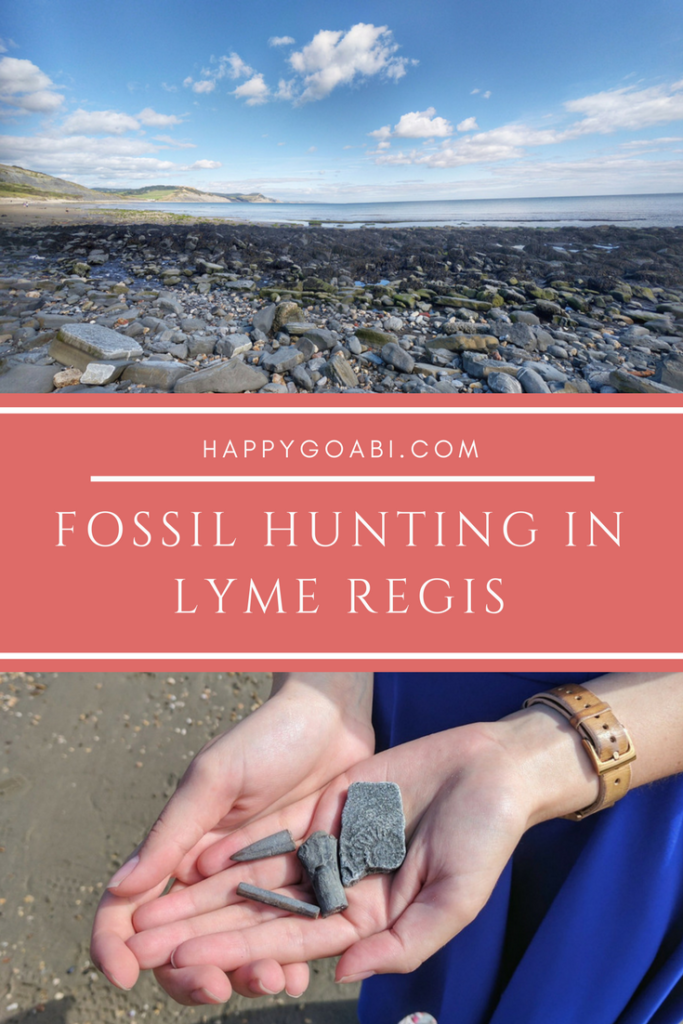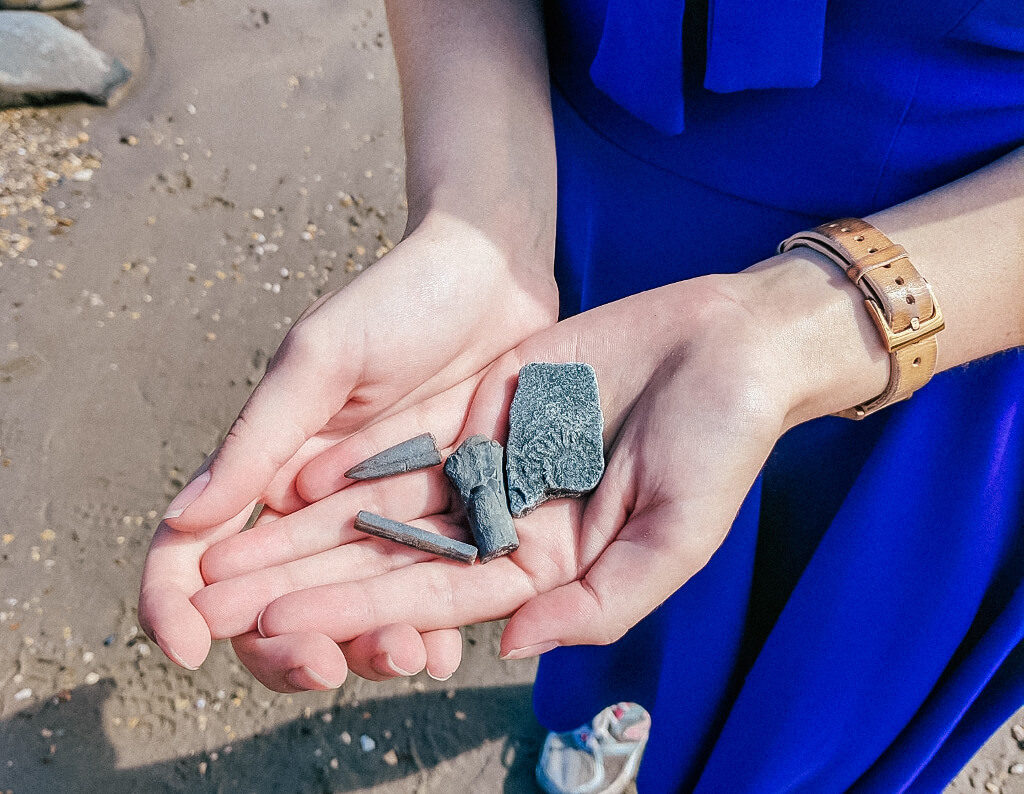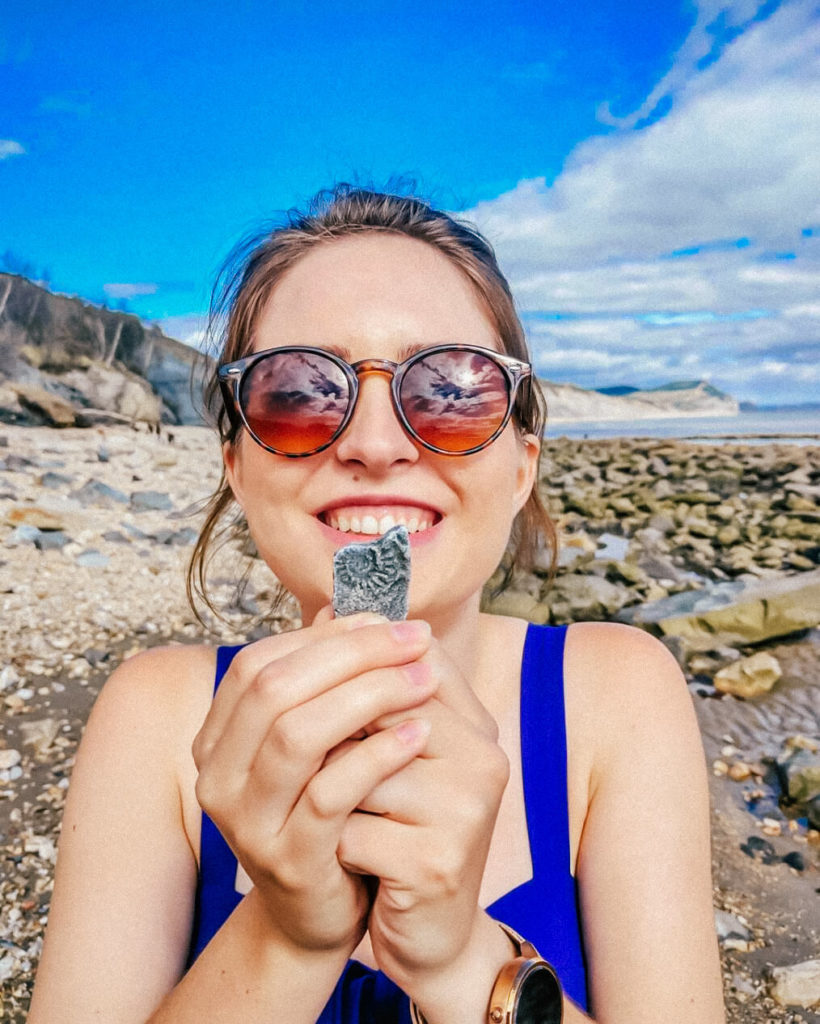Lyme Regis, England: maybe you’ve heard of it, but probably you haven’t.
Little old literary me had wanted to visit here ever since I first learned of its connection to Jane Austen and Persuasion…but I had no inkling of the excitement I would discover in this sweet little seaside town.
My excitement can be explained in two words: DINOSAUR. FOSSILS.
Hear me out—Lyme Regis is that adorable little seaside town with cute buildings, coastal boutiques, fishing and boating, fish and chips, and the inexorable call of the sand and sea. It is the town of Jane Austen and Anne Eliot, Captain Wentworth, and Louisa Musgrove.
But it is also something else. Something more. Something stupendously sensational and unbelievable.
Yes, that’s right—it’s a place where the past collides with the present. A place where you can go fossil hunting and try to find your very own dinosaur!

What?! Fossil Hunting in Lyme Regis?
You heard me. You can go fossil hunting in Lyme Regis.
As a regular beach-going human, you’ve probably combed the coast for seashells, sand dollars, or sea glass before—but now you can take it a step further and find fossils. That you get to keep.
That’s right, you can keep anything you find! Welcome to the Jurassic Coast, land of dinosaurs and dreams!

Lyme Regis: The Jurassic Coast
If you’ve ever watched the Jurassic Park franchise and desperately coveted your very own Velociraptor or Compsognathus (so cute!), then you have to go fossil hunting at Lyme Regis. You just have to.
In the early hours of the morning when only joggers are around, stepping onto the shore feels like being transported back to the Jurassic Period. Everything is still and calm except the quiet lapping of the waves, while the sun grazes the horizon as it glides into the sky.
Who’s to say that a dinosaur won’t come bounding across the green hills? Or that an ichthyosaur won’t swim up to meet you?
Obviously it’s unlikely (to say the least) that you’ll meet a living dinosaur or ichthyosaur during your visit, but it isn’t all that unlikely that you’ll find a piece of one. Of course, it’ll take some luck and some skill and some good fossil-hunting weather…but all in all it is a pretty good possibility.
Mary Anning and the History of Fossils at Lyme Regis
Interestingly, Lyme Regis holds a special place in fossil hunting history and in the history of women fossil hunters.
In the 19th century, a girl named Mary Anning lived with her family in Lyme Regis. Her father was a cabinetmaker, but he supplemented the family’s income by searching for and selling fossils. He would often take Mary and her brother Joseph out to hunt for fossils with him.
However, he died when Mary was eleven, so Mary and her brother took over the fossil business and continued to mine the hills—finding seashells and fossils to sell to the tourists who came to Lyme Regis as a seaside resort.
When Mary was twelve, Joseph found an ichthyosaur skull…and soon after Mary uncovered the rest of its skeleton. Over the years, she continued to make large and meaningful finds—dodging death as cliffs collapsed and uncovering important fossils that had never been found before.
In December of 1823, she uncovered the first complete Plesiosaurus…and her finds did not stop there!
However, as we well know, the 19th century (and especially 19th-century male scientists) were not kind to women like Mary Anning. Despite her amazing and unprecedented finds, the men who wrote scientific papers about these discoveries often did not give her credit for these finds that she uncovered, prepared, and identified. And the Geological Society of London? Well, they refused to admit her on the grounds that they simply could not accept women into their society.
Despite this sad state of affairs, today we recognize her as the true, groundbreaking pioneer she was. And today, many of her fossils are on display in the Natural History Museum of London—with full credit—for the whole public to see.
So while you’re in Lyme Regis and fossil hunting, take a moment to remember this hero fossil collector and paleontologist—a pioneer in her field and a pioneer for all the women who would follow in her footsteps!
Preparing for Jurassic Coast Fossil Hunting
Lyme Regis was rich in fossils before and is still rich in fossils today, which makes it an exciting place to hunt.
If it’s your first time fossil hunting, you may find it helpful to familiarize yourself with some of the types of fossils you might find.
At nearly anytime of year, you are practically guaranteed to at least find spiral ammonites and bullet-shaped belemnites—the most common finds on the coast (but still super exciting!)
How to Hunt for Fossils in Lyme Regis
1. Take a walk
During my time in Lyme Regis, I enjoyed walking around on my own and examining the sand and rocks to search for fossils. It really is that easy!
Many ammonites, belemnites, and other common fossils come loose and are simply waiting to be found in the rocks and sand across the beach. This is the easiest way to search for fossils, and does not require any equipment.
However, if you want to search more intensely, you may wish to have a hammer and chisel on hand (and protective eyewear!) so that you can open or chisel away rock to find the more hidden fossils.
2. Go on Lyme Regis fossil walks
Your second option is to go on a Lyme Regis walk with a company in Lyme Regis. This is helpful if it is your first time fossil hunting, as they have all the tools needed and will help guide you to the best places to hunt.
After hunting on my own for a while, I joined up with a fossil walk led by Paddy Howe from the Lyme Regis Museum. This was an excellent opportunity to learn more about the fossils on the Jurassic Coast and this region’s history!
Keep in mind that if you do choose this option, you may need to book in advance as the tours (especially at the museum) usually fill up early!

The Best Time to Go Fossil Hunting
If you are serious about wanting to find super cool fossils, the best time to go fossil hunting in Lyme Regis is during the rainy, stormy, super-terrible-weather-y time of year.
This is because the storms and downpours unearth new areas of the cliffs that haven’t been unearthed before…and with this comes mudslides and fossils! Of course, if you choose to go during the winter and stormy months, you will need to beware of the sliding cliffs so that you don’t get buried accidentally (that is what happened once to Mary Anning’s dog…and what nearly happened to her too!).
If you choose to go during the winter months, you’ll also need all the boots and waterproof equipment to allow you to traipse around in the mud. So bear that in mind while you decide the best time to visit.
So, the best time to find fossils is during the rainy season, but if your goal is just to have fun and maybe find an ammonite or two then you may prefer the sunny and comparatively-warm summer months. You probably won’t make a big find in the summer, but the process of looking will be more enjoyable 😉
Is it Worth It to Fossil Hunt in Lyme Regis?
Yes, unequivocally yes!
Whether you go in the winter or summer months, fossil hunting in Lyme Regis will be an unforgettable experience!
I’m still holding out hope that someday a living Compsognathus will run up to me on the beach at Lyme Regis and want to be my friend…but finding fossil vertebrae, molluscs, and the possibility of discovering larger specimens certainly makes for an enjoyable alternative.
Whatever your age and whoever you visit Lyme Regis with, fossil hunting is a fun and rewarding recreational activity to liven up your day. And who knows, maybe you’ll discover a new species and be the next Mary Anning?
Save for Later





